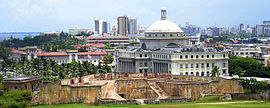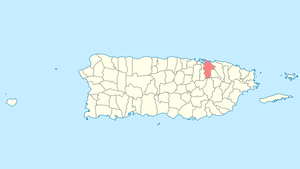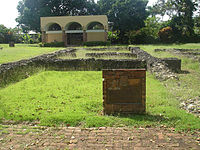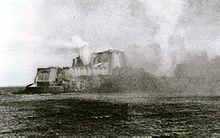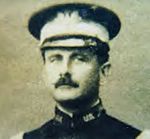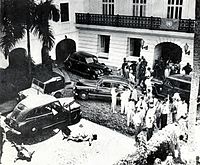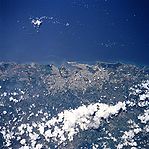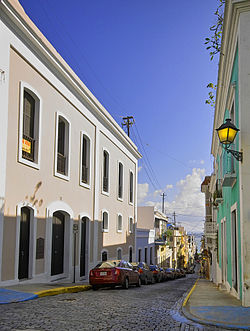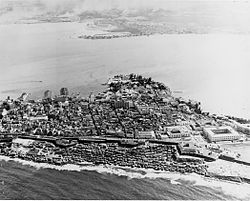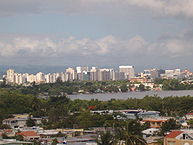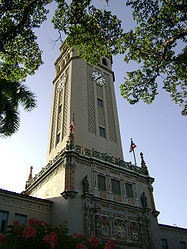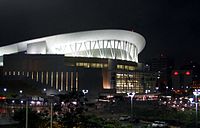- San Juan, Puerto Rico
-
San Juan Bautista — Municipality — 
Flag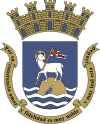
Coat of armsNickname(s): La Ciudad Amurallada (The Walled City), Ciudad Capital (Capital City) Location of San Juan in Puerto Rico Coordinates: 18°27′00″N 66°04′00″W / 18.45°N 66.0666667°WCoordinates: 18°27′00″N 66°04′00″W / 18.45°N 66.0666667°W Country United States Territory Puerto Rico Established 1509[1] Named for John the Baptist Government – Mayor Jorge A. Santini Padilla (PNP) – Senatorial dist. 1 - San Juan/Guaynabo – House dist. 1,2,3,4,5 Area[2] – Total 76.93 sq mi (199.2 km2) – Water 29.11 sq mi (75.4 km2) 37.83% Population (2010)[3] – Total 395,326 – Density 5,138.8/sq mi (1,984.1/km2) – Racial groups
(2010 Census)[4]68.0% White
18.6% Black
0.8% American Indian/AN
0.4% Asian
0.0% Native Hawaiian/PI
8.2% Some other race
4.0% Two or more racesDemonym Sanjuaneros Time zone AST (no daylight saving time) (UTC-4) ZIP codes 00901-02, 00906-17, 00919-21, 00923-31, 00933-34, 00936, 00939-40 Area code 787, 939 Website www.sanjuan.pr San Juan (Spanish pronunciation: [saŋ ˈxwan], Saint John; English: /ˌsæn ˈhwɑːn/), officially Municipio de la Ciudad Capital San Juan Bautista (Municipality of the Capital City, Saint John the Baptist), is the capital and most populous municipality in Puerto Rico, an unincorporated territory of the United States. As of the 2010 census, it had a population of 395,326 making it the 46th-largest city under the jurisdiction of the United States. San Juan was founded by Spanish colonists in 1521, who called it Ciudad de Puerto Rico ("Rich Port City"). Puerto Rico's capital is the second oldest European-established city in the Americas, after Santo Domingo, in the Dominican Republic.[5] Several historical buildings are located in San Juan; among the most notable are the city's former defensive forts, Fort San Felipe del Morro and Fort San Cristóbal, and La Fortaleza, the oldest executive mansion in continuous use in the Americas.
Today, San Juan is one of Puerto Rico's most important seaports,[6] and is the island's manufacturing[citation needed], financial, cultural, and tourism center. The population of the Metropolitan Statistical Area, including San Juan and the municipalities of Bayamón, Guaynabo, Cataño, Canóvanas, Caguas, Toa Alta, Toa Baja, Carolina and Trujillo Alto, is about 2 million inhabitants; thus, about half the population of Puerto Rico now lives and works in this area.[7] San Juan is also a principal city of the San Juan-Caguas-Fajardo Combined Statistical Area. The city has been the host of numerous important events within the sports community, including the 1979 Pan American Games, 1966 Central American and Caribbean Games, 2006 and 2009 World Baseball Classics, the Caribbean Series and the Special Olympics and MLB San Juan Series in 2010.
Contents
History
In 1508, Juan Ponce de León founded the original settlement Caparra (named after the province Caceres, Spain, the birthplace of then-governor of Spain's Caribbean territories Nicolás de Ovando),[8] which today is known as the Pueblo Viejo sector of Guaynabo, just to the west of the present San Juan metropolitan area. A year later, the settlement was moved to a site then called Puerto Rico, Spanish for "rich port" or "good port", after its similar geographical features to the island of Gran Canaria in the Canary Islands.[9] In 1521, the newer settlement was given its formal name, San Juan Bautista de Puerto Rico, in honor of John the Baptist, following the tradition of christening the town with both its formal name and the name which Christopher Columbus had originally given the island.
The ambiguous use of San Juan Bautista and Puerto Rico for both the city and the island led to a reversal in practical use by most inhabitants: by 1746, the name for the city (Puerto Rico) had become that of the entire island, while the name for the Island (San Juan Bautista) had become the name for the city.[10][11]
San Juan, as a settlement of the Spanish Empire, was used by merchant and military ships traveling from Spain as the first stopover in the Americas. Because of its prominence in the Caribbean, a network of fortifications was built to protect the transports of gold and silver from the New World to Europe. Because of the rich cargoes, San Juan became a target of the foreign powers of the time.[12]
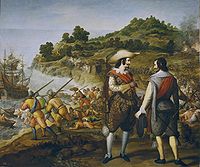 Seventeenth-century Spanish painting commemorating Captain Juan de Amezquita's victory and Enrico's defeat at San Juan de Puerto Rico; by Eugenio Caxés, Museo del Prado
Seventeenth-century Spanish painting commemorating Captain Juan de Amezquita's victory and Enrico's defeat at San Juan de Puerto Rico; by Eugenio Caxés, Museo del Prado
The city was witness to attacks from the English led by Sir Francis Drake in 1595 (in what is known as the Battle of Puerto Rico) and by George Clifford, Earl of Cumberland, in 1598. Artillery from San Juan's fort, El Morro, repelled Drake; however, Clifford managed to land troops and lay siege to the city.[13] After a few months of British occupation, Clifford was forced to abandon the siege when his troops began to suffer from exhaustion and sickness. In 1625 the city was sacked by Dutch forces led by Captain Balduino Enrico (also known as Boudewijn Hendricksz/Bowdoin Henrick), but El Morro withstood the assault and was not taken. The Dutch were counterattacked by Captain Juan de Amezquita and 50 members of the civilian militia on land and by the cannons of the Spanish troops in El Morro Castle. The land battle left 60 Dutch soldiers dead and Enrico with a sword wound to his neck which he received from the hands of Amezquita.[14] The Dutch ships at sea were boarded by Puerto Ricans who defeated those aboard. After a long battle, the Spanish soldiers and volunteers of the city's militia were able to defend the city from the attack and save the island from an invasion. On October 21, Enrico set La Fortaleza and the city ablaze. Captains Amezquita and Andre Botello decided to put a stop to the destruction and led 200 men in an attack against the enemy's front and rear guard. They drove Enrico and his men from their trenches and into the ocean in their haste to reach their ships.[15]
The English attacked again in 1797, during the French Revolutionary Wars, led by Sir Ralph Abercromby (who had just conquered Trinidad). His army laid siege to the city but was forced to withdraw in defeat as the Puerto Rican defenses proved more resilient than those of Trinidad. Various events and circumstances, including liberalized commerce with Spain, the opening of the island to immigrants as a direct result of the Royal Decree of Graces of 1815, and the colonial revolutions, led to an expansion of San Juan and other Puerto Rican settlements in the late 18th and early 19th century.
On May 8, 1898, United States Navy ships, among them the USS Detroit, USS Indiana, USS New York, USS Amphitrite, USS Terror and USS Montgomery, commanded by Rear Admiral William T. Sampson arrived at San Juan Bay.[16][17] The USS Yale captured a Spanish freighter, the Rita in San Juan Bay, thus being the first hostile encounter between the warring sides in Puerto Rico. On May 9, Yale fought a brief battle with an auxiliary cruiser of Spain, name unknown, resulting in a Spanish victory. Around this time, Captain Ángel Rivero Méndez was assigned the command of the Spanish forces in the fortress of San Cristóbal in San Juan. On May 10, the Yale returned to San Juan Bay, Rivero-Méndez ordered his men to open fire upon the USS Yale using an Ordoñez 15 centimeter cannon, thus becoming the first attack against the Americans in Puerto Rico during the Spanish-American War.[18] For his actions, Captain Rivero-Mendez was awarded the "Cruz de la Orden de Merito Militar" (The Cross of the Order of the Military Merit) first class.[18] The residents of San Juan were furious with Rivero and blamed him for the destruction caused to their city by the American bombardments. Nothing came of those accusations and Capt. Rivero-Méndez was ordered to turn over the keys of all the military installations in San Juan to Captain Henry A. Reed of the U.S. Army after the Treaty of Paris of 1898 was signed.[18] On July 25, General Nelson A. Miles landed at Guánica (in southwestern Puerto Rico) with 3,300 soldiers in what was known as the Puerto Rico Campaign. The American troops found some resistance and engaged the Spanish and Puerto Rican troops in battle, the most notable of these the Battles of Yauco and Asomante. All military actions in Puerto Rico were suspended August 13, 1898, after President William McKinley and French Ambassador Jules Cambon, acting on behalf of the Spanish government, signed an armistice.[19][20] Spain ceded the island to the United States later the same year by signing the Treaty of Paris.
Camp Las Casas, located in the district of Santurce, served as the main training camp for the Puerto Rican soldiers prior to World War I and World War II; the majority of the men trained in this facility were assigned to the "Porto Rico Regiment of Infantry" which was renamed the 65th Infantry Regiment of the United States Army by the Reorganization Act of June 4, 1920. The 65th Infantry was deactivated in 1956 and became the only unit ever to be transferred from an active Army component to the Puerto Rico National Guard.[21]
Lieutenant Teofilo Marxuach (Retired as a Lieutenant Colonel), a native of Arroyo, Puerto Rico, fired the first shot in what is considered to be the first shot of World War I fired by the regular armed forces of the United States against any ship flying the colors of the Central Powers[22] Marxuach, who was a member of the "Porto Rico Regiment of Infantry" and Officer of the Day, on March 25, 1915, opened fire on the Odenwald, an armed German supply vessel, when it was trying to force its way out of San Juan's bay.[23] The shots ordered by Lt. Marxuach were the first fired by the United States in World War I.[24]
In 1919, Félix Rigau Carrera, "El Aguila de Sabana Grande" (The Eagle from Sabana Grande), the first Hispanic fighter pilot in the United States Marine Corps and first Puerto Rican pilot, became the first native Puerto Rican to fly an aircraft in the island when he flew his Curtiss JN-4 from Las Casas. At the time, the area was used by the military as an air base and it was also Puerto Rico's first commercial airport, and Rigau Carrera was allowed to perform his historic flight from the air field.[25] Camp Las Casas was eventually closed down, and in 1950 a public housing project by the name of Residencial Fray Bartolome de Las Casas was constructed on its former location.
On January 2, 1947, the people of San Juan elected Felisa Rincón de Gautier (also known as Doña Fela) (1897–1994) as their mayor. Thus, she became the first woman to be elected as the Mayor of a capital city in any of The Americas.[26] During the Cold War era, she ordered the establishment of the island's first Civil Defense system under the directorship of Colonel Gilberto Jose Marxuach (Teofilo's son).[27] Rincón de Gautier served as mayor until January 2, 1969.
On October 30, 1950, San Juan was the scene of the San Juan Uprising, one of many uprisings which occurred in various towns and cities in Puerto Rico, by the Puerto Rican Nationalist Party against the governments of Puerto Rico and the United States. Among the uprising's main objective was to attack "La Fortaleza" (the Governors mansion) and the United States Federal Court House Building in Old San Juan. In accordance to the planned uprising in San Juan, a group of nationalists were supposed to attack simultaneously the gubernatorial mansion La Fortaleza, where Puerto Rican governor Luis Muñoz Marín resided, and the United States Federal Court House which is located close to an area called "La Marina" in Old San Juan. The La Fortaleza battle, which ensued between the nationalists and the police lasted 15 minutes, and ended when four of the five attackers were killed.[28]
Coat of arms and flag of San Juan
On March 8, 1948 the city government of San Juan officially adopted as the city's first flag an orange field, in the center of which is the Coat of Arms of the City. The orange color was based and taken from Father Diego de Torres Vargas' text and it reads : "Escudo de armas dado a Puerto Rico por los Reyes Católicos en el año de 1511, siendo Procurador un vecino llamado Pedro Moreno. Son : un cordero blanco con su banderilla colorada, sobre un libro, y todo sobre una isla verde, que es la de Puerto Rico, y por los lados una F y una I, que quiere decir Fernando e Isabel, los Reyes Católicos que se las dieron, y hoy se conservan en el estandarte real, que es de damasco anaranjado, con que se ganó la ciudad" ("Coat of Arms given to Puerto Rico by the Catholic Monarchs in the year 1511 being Procurator a vecino named Pedro Moreno. They are: a white lamb with a red flag, on top of a book, and everything above a green island, which is Puerto Rico...which is of orange damask, with which the city was won"). It appears that the color was changed from orange to white at some point.[29]
Geography
San Juan is located along the north-eastern coast of Puerto Rico. It lies south of the Atlantic Ocean; north of Caguas and Trujillo Alto; east of and Guaynabo; and west of Carolina. The city occupies an area of 76.93 square miles (199.2 km2), of which, 29.11 square miles (75.4 km2) (37.83%) is water. San Juan's main water bodies are San Juan Bay and two natural lagoons, the Condado and San José.[30]
Climate
San Juan features a Tropical monsoon climate (Koppen Am). San Juan enjoys an average temperature of 79.9 °F (26.6 °C) although 90 °F (32 °C) or higher temperatures are often felt during the summer, especially if the winds come from the south. In the winter, temperatures can drop to the 60s, though the average winter low is 71 °F (22 °C). The coldest temperature ever recorded was 60 °F (16 °C) on March 3, 1957, and the hottest was 98 °F (37 °C) on October 9, 1981.[31] Rainfall is well-distributed throughout the year, but the months of January, February, and March are the driest; as February averages just under 2.36 inches (60 mm) of rain, the city falls under the tropical monsoon category. Rain averages nearly 51 inches (130 cm), falling on an average 194 days per year;[32] despite this dampness, the city averages nearly 3,000 hours of sunshine per year, or just over 2/3 of the possible total.[33]
San Juan averages 50.75 inches (1,289 mm) of rain per year. Because in its driest month San Juan's receives just under 2.36 inches (60 mm), it falls under the Tropical monsoon climate category.[34]
Climate data for San Juan, Puerto Rico Month Jan Feb Mar Apr May Jun Jul Aug Sep Oct Nov Dec Year Record high °F (°C) 92
(33)96
(36)96
(36)97
(36)96
(36)97
(36)95
(35)97
(36)97
(36)98
(37)96
(36)94
(34)98
(37)Average high °F (°C) 82.4
(28.0)82.8
(28.2)83.4
(28.6)84.9
(29.4)86.3
(30.2)87.6
(30.9)87.4
(30.8)87.8
(31.0)87.8
(31.0)87.5
(30.8)85.1
(29.5)83.2
(28.4)85.5 Daily mean °F (°C) 76.6
(24.8)76.9
(24.9)77.6
(25.3)79.1
(26.2)80.6
(27.0)82.1
(27.8)82.2
(27.9)82.4
(28.0)82.2
(27.9)81.6
(27.6)79.6
(26.4)77.7
(25.4)79.9 Average low °F (°C) 70.8
(21.6)70.9
(21.6)71.7
(22.1)73.2
(22.9)74.9
(23.8)76.6
(24.8)76.9
(24.9)77
(25)76.5
(24.7)75.6
(24.2)74
(23)72.1
(22.3)74.2 Record low °F (°C) 61
(16)62
(17)60
(16)64
(18)66
(19)69
(21)69
(21)69
(21)69
(21)67
(19)66
(19)63
(17)60
(16)Rainfall inches (mm) 3.02
(76.7)2.30
(58.4)2.14
(54.4)3.71
(94.2)5.29
(134.4)3.51
(89.2)4.16
(105.7)5.22
(132.6)5.60
(142.2)5.06
(128.5)6.17
(156.7)4.57
(116.1)50.76
(1,289.3)Avg. rainy days (≥ 0.01 in) 17.6 13.4 12.9 12.0 14.6 14.0 17.9 18.3 17.3 17.3 19.4 19.2 193.9 Sunshine hours 238.7 234.5 282.1 267.0 254.2 258.0 282.1 266.6 234.0 226.3 201.0 217.0 2,961.5 Source no. 1: The Weather Channel (records)[31] Source no. 2: NOAA (normals, 1971-2000),[32] HKO[33] http://www.city-data.com/states/Puerto-Rico-Climate.html
Cityscape
Old San Juan occupies the western end of a rocky islet at the mouth of San Juan Bay. During the 20th century, the main population centers surged well beyond the walls of the old city and onto Puerto Rico's main island, and merged with the existing settlements east and south of Old San Juan. As a result, the city is now composed of a variety of neighborhoods.
Old San Juan
During the Spanish colonial times most of the urban population resided in what is now known as Old San Juan. This sector is located on the western half of a small island called the Isleta de San Juan, which is connected to the mainland by two bridges and a causeway. The small island, which comprises an area of 47 square miles (122 km2), also hosts the working class neighborhood of Puerta de Tierra and most of Puerto Rico's central government buildings, including the Commonwealth's Capitol. The main central part of the city is characterized by narrow streets made of blue cobblestone and picturesque colonial buildings, some of which date back to the 16th and 17th century. Sections of the old city are surrounded by massive walls and several defensive structures and notable forts. These include the 16th-century Fort San Felipe del Morro and the 17th-century Fort San Cristóbal, both part of San Juan National Historic Site, and the 16th-century El Palacio de Santa Catalina, also known as La Fortaleza, which serves as the governor's mansion.[35] Other buildings of interest predating the 20th century are the Ayuntamiento or Alcaldía (City Hall), the Diputación Provincial and the Real Intendencia buildings, which currently house the Puerto Rico Department of State,[36] the Casa Rosa, the San José Church (1523) and the adjacent Hotel El Convento, the former house of the Ponce de León family known as Casa Blanca, the Teatro Tapia, the former Spanish barracks (now Museum of Ballajá), La Princesa (former municipal jail, now headquartering the Puerto Rico Tourism Company), and the municipal cemetery of Santa María Magdalena de Pazzi, located just outside the city walls.[37][38][39] The Cathedral of San Juan Bautista (construction began in the 1520s) is also located in Old San Juan, and contains the tomb of the Spanish explorer and settlement founder Juan Ponce de León.[40] Old San Juan, also known as the "old city", is the main cultural tourist attraction in Puerto Rico; its bayside is lined by dock slips for large cruise ships.
Districts
San Juan is subdivided into 18 districts,[41] 16 of which fall within the former (until 1951) Municipio de Río Piedras. Eight districts are further subdivided in to sectors, including two districts in the area that covered the original municipality of San Juan.
- Caimito
- Cupey
- El Cinco
- Gobernador Piñero
- Hato Rey Central
- Hato Rey Norte
- Hato Rey Sur
- Monacillo
- Monacillo Urbano
- Oriente
- Pueblo
- Quebrada Arenas
- Sabana Llana Norte
- Sabana Llana Sur
- Old San Juan
- Santurce
- Tortugo
- Universidad
East of Old San Juan lies the wealthy tourist-oriented neighborhood of Condado, which occupies land that used to be owned by entrepreneur Pablo Ubarri Capetillo, a Spanish railroad developer and Count of San José de Santurce under the Spanish colonial period. Beaches such as nearby Ocean Park, popular with swimmers, surfers and kitesurfers, are found all along the district's Atlantic coastline which is also the locus of numerous hotels.[42]
Near Condado are two separate business districts, Santurce and Miramar. Miramar is mainly a residential area rising south of the Condado Lagoon. It comprises the former barrio of Miraflores, as well as drained marshland and landfill over which was built San Juan's first airport, the Isla Grande airport, which was renamed Fernando Luis Ribas Dominicci Airport in honor of Major Fernando Luis Ribas-Dominicci (USAF). Miramar now hosts the Puerto Rico Convention Center as well as some of San Juan Harbor's cruise ship piers. In 2005 Miramar was designated an historical district of Puerto Rico.[43]
Santurce, originally named San Mateo de Cangrejos (Saint Matthew of the Crabs), was a settlement for freed African slaves during the early days of the city. After Pablo Ubarri sought permission to link San Juan with Río Piedras proper via steam tramway in 1878, the time it took to travel between both points were shortened and thereby stimulated the colonization and growth of the district. At the beginning of the twentieth century an electric trolley was installed, the township was split into three parts, and its main settlement, merged with the city, was renamed using the Spanish spelling of Santurtzi (Saint George in Basque), Ubarri's birthplace in Vizcaya, Spain. The "Museo de Arte de Puerto Rico" (Puerto Rico Museum of Art)[44] and other important cultural venues are located in Santurce.
South of Santurce is Hato Rey, part of the former municipality of Río Piedras. Hato Rey was grazing ground for cattle owned by the royal government (hence its name, the King's Herd in Spanish) as early as the 16th century,[45] and is now considered the financial center of the island. A section of this district is often referred to as Milla de Oro (actually 0.47 miles / 0.76 kilometres long) due in part to the many banks and businesses located there.[45]
In the southern part of the city is the socially diversified community of Río Piedras. Founded in the mid 1850s, Río Piedras was a separate town which hosted sugar cane plantations and the estates of some of San Juan's wealthiest inhabitants (as well as their working class staff). The Spanish colonial governors also had their summer home there on land which eventually gave way to the main campus of the University of Puerto Rico. In 1951 the municipalities of San Juan and Río Piedras were merged to redefine San Juan's current city limits. Today Río Piedras comprises the largest area of the municipality of San Juan.[46] and is home to the renowned, traditional "Plaza del Mercado" (Río Piedras Marketplace), the main campus and the Medical Sciences campus of the University of Puerto Rico and the San Juan Botanical Garden.
Demographics
Race - San Juan, Puerto Rico - 2010 Census[47] Race Population % of Total White 268,708 68.0% Black/African American 73,538 18.4% American Indian and Alaska Native 3,071 0.8% Asian 1,750 0.4% Native Hawaiians/Pacific Islander 36 0.0% Some other race 32,386 8.2% Two or more races 15,835 4.0% 

San Juan is the largest city in Puerto Rico in population.[2] From 1899 to 1950 the municipality of San Juan excluded the township of Río Piedras. For this reason, population data and land area for the period make reference only to the Antiguo San Juan and Santurce barrios, or subdivisions, of San Juan. The old municipality of Río Piedras constituted the third most populated city of Puerto Rico at the time of its annexation in 1951. Its strategic location south of the capital served as a junction for all the principal ways of transportation of the island and as a geographical entry to San Juan, which are factors that prompted Río Piedras's dramatic urban development in the 20th century.
According to the 2010 Census, the racial composition of San Juan was as follows:
- White: 68.0% (Non-Hispanic Whites: 1.2%)
- Black or African American: 18.3% (Non-Hispanic Blacks: 0.3%)
- American Indian: 0.8%
- Asian: 0.4%
- Native Hawaiian/Pacific Islander: 0.0%
- Some other race: 8.2%
- Two or more races: 4.0%
- Hispanic or Latino (of any race): 98.2%
Among the Hispanic and Latino population, Puerto Ricans are, unsurprisingly, the largest group; they make up 87.5% of San Juan's Hispanic population. People of Dominican descent made up 12.2% of the Hispanic population, while those of Cuban descent formed 1.7% of the Hispanic populace. Other Hispanic and Latino groups collectively formed 3.2% of San Juan's Hispanic population.
There are 13,304 whites of non-Hispanic origin living in San Juan; 10,571 blacks of non-Hispanic origin living in San Juan. Non-Hispanic whites and blacks form 3.2% and 2.6% of San Juan's population respectively. There are also approximately 562 Asians of non-Hispanic origin in San Juan; they make up only 0.14% of the population. However, Asians of Hispanic and non-Hispanic origin together number at 6,342. The vast majority of Asians in San Juan are of Chinese descent; of the 6,342 Asians, 4,928 are Chinese. Chinese comprise 1.4% of the population. The only other sizable Asian group in San Juan are Indian Americans; there are 698 people of Indian descent in the city, forming 0.2% of the population. There are very small numbers of people of Filipino, Japanese, and Vietnamese ancestry; none of these groups number more than 100 members.[48]
According to the 2006–2008 American Community Survey, 87.5% of San Juan's population was native and 12.5% were foreign-born. Of the native population, 86.9% were born in Puerto Rico or the United States, of which 75.6% were born in Puerto Rico and 8.9% were born in the United States. The remaining 0.7% were born in a U.S. territory or were born abroad to American parents. The remaining 11.9% of the population were born outside the United States, Puerto Rico, and U.S. territories. In recent years, an increasing number of Americans not of Hispanic ancestry (both of African American and of White American descent) have moved to San Juan. In addition, a large number of Stateside Puerto Ricans have settled in the city upon their return to Puerto Rico. There is also a growing West Indian population, both of Hispanic and non-Hispanic origin.
In terms of ancestry, 23,875 people claimed American ancestry, which is equivalent to 5.8% of San Juan's population. Other sizable ancestry groups included those of Italian descent, French descent, and West Indian descent. People of Italian descent numbered at 1,694, forming 0.4% of the population; people of French descent numbered at 1,064, forming 0.2% of the population. Finally, those of West Indian descent numbered at 1,393, forming 0.3% of San Juan's population. Approximately 1,026 people claimed Sub-Saharan African ancestry; 719 claimed Irish ancestry; 646 claimed German ancestry; 431 claimed Arab ancestry, and 346 claimed English ancestry. There are many other ancestry groups in San Juan, but they are very scant.[49]
Economy
San Juan experienced significant economic growth following World War II. During this period the city underwent an industrial revolution.[50] The city's economy relies mostly on companies dedicated to the manufacture of several products, including: Chemical substances (bleach and house cleaning products); medicines; rum and other beverages; fertilizers; electric tools; electronic devices; plastics, textiles, and food-based products.[50] Tourism is also a key industry, based on San Juan's proximity to Puerto Rico's main airport, the Luis Muñoz Marín International Airport.[50] The tourism focus of the city is located in the district of Condado Beach where there are numerous luxurious hotels.[50] Historical locations such as El Morro, Old San Juan and El Cuartel de Ballaja are promoted in tourism campaigns. The district of Hato Rey contains a corporate sector known as "La Milla de Oro," (The Golden Mile) which serves as the headquarters of numerous local and international banks. San Juan's Hato Rey district is often referred to as the "Wall Street of the Caribbean," due to the influence of the area on Puerto Rico and the Caribbean's economy.[45]
Tourism
Technological advances after World War II in the development of the airliner, coupled with the island's climate and natural setting, have transformed San Juan into the springboard for tourism around the island, and has made the rest of the Caribbean known throughout the world during the last fifty years.[51] Today the capital features numerous hotels, museums, historical buildings, restaurants, beaches and shopping centers. In San Juan there are numerous tourist attractions, including: Old San Juan, Ocean Park, Isla Verde and Condado.
Places and monuments emphasized in tourism campaigns include: Old San Juan, promoting the historic nature of its colonial buildings and narrow streets covered by adoquine, a blue stone cast from furnace slag; they were brought over as ballast on Spanish ships.[50] This includes the city's ancient defensive wall and forts, most notably El Morro and the Castle of San Cristóbal.[50] On January 23, 1984 both of these edifices were catalogued as being part of humanity's cultural patrimony.[50] The numerous restaurants and art galleries in the zone are frequently visited by tourists.[50] The local universities are promoted as historic places, most notably the campus of University of Puerto Rico located in Río Piedras, which is the oldest university on the island being founded in 1903.
Culture
See also: List of notable residents of San Juan, Puerto RicoSan Juan is the birthplace of numerous artists and musicians, locally known as Sanjuaneros, who have significantly influenced Puerto Rican culture. During the 20th century, the musical aspect of the city was influenced by performers including Afro-Caribbean dancer and choreographer Sylvia del Villard and José Enrique Pedreira who became a renowned composer of Puerto Rican Danzas. International musicians such as renowned opera singer Justino Díaz and Grammy Award winners Raymond Ayala and Ricky Martin were born in the city. Other notable residents include writers Giannina Braschi and Tomas Blanco, award-winning actors Raúl Juliá and Benicio del Toro, and comedian José Miguel Agrelot. Rafael Cordero (1790–1868), was influential in the development of Puerto Rican education and is renowned as " The Father of Public Education in Puerto Rico." The city is also the home of numerous contemporary and classic art museums. The Puerto Rico Arts Museum owns the largest collection of contemporary art in Puerto Rico, housing over 1,100 permanent art pieces and displaying numerous temporary exhibitions containing artwork from various locations through Latin America.[52]
The Museum of Contemporary Art of Puerto Rico, located in Santurce, specializes in contemporary artwork from Latin America and the Caribbean. The paintings displayed in the permanent exhibition are either acquired by the museum's administrative personnel or donated by artists and collectors. They are judged by a panel of painters, art critics, and scholars before being displayed.[53]
Other museums such as the Pablo Casals Museum, the Book Museum, Americas Museum and the National Gallery display historic items and artwork alongside contemporary art.[54][55] Miscellaneous museums such as the Children's Museum and the Bacardi Distillery (also known as the "Rum Cathedral") in nearby Cataño appeal to different audiences through interactive exhibitions.[56][57]
Government
As one of Puerto Rico's 78 municipalities, San Juan's government is compromised of two branches, the executive and the legislative. Those citizens eligible to vote directly elect a mayor and the municipal assembly for four-year terms. The municipal government is housed in City Hall or Casa Alcaldia, which is located at 153 San Francisco Street, facing the Plaza de Armas or Military Square at the center of Old San Juan.[58] City Hall was constructed based on Madrid's City Hall starting in 1604 and finally completed in 1789.[58]
The executive branch is headed by a popularly elected mayor. The office is currently held by Jorge A. Santini. In addition to running the city's day-to-day operations and supervising associated departments, the mayor is also responsible for appointing a secretary-auditor and a treasurer. San Juan's Municipal Legislature is made up of 17 municipal legislators, elected at-large, which represent the city's population.[59]
Safety
In 2010 there were 201 slayings in San Juan. A rate of around 50 per 100,000 residents. Law enforcement in San Juan is the joint responsibility of the Department of Police and Public Safety also known as the San Juan Police Department and the Puerto Rico Police Department.[60] The Municipal Police, originally known as the "San Juan Municipal Guard", was created in 1521 and has active military and law enforcement functions, until 1980 when act#77 created municipal law enforcement agencies in Puerto Rico. It currently employs over 1,000 sworn officers plus civilian staff.[61]
Education
- Colleges and Universities
San Juan is home to many of Puerto Rico's institutions of higher learning. The University of Puerto Rico Río Piedras Campus is located in San Juan, along with the University of Puerto Rico's Medical Sciences Campus. Other colleges located in San Juan are the University of the Sacred Heart, the Polytechnic University of Puerto Rico, the Ana G. Méndez University System's Metropolitan University, the Metropolitan Campus of the Inter American University of Puerto Rico, the Carlos Albizu University, the Evangelic Seminary of Puerto Rico and the Center for Advanced Studies on Puerto Rico and the Caribbean. There are numerous smaller colleges located in the city, including the ICPR Junior College, the Instituto de Banca y Comercio and the International Junior College, located in Santurce.[62] There are also several technical schools based in San Juan, including the Technological College of San Juan, the Liceo de Artes y Ciencias, Ramirez College of Business and Technology, and the Puerto Rico Technical Junior College. The Puerto Rico Conservatory of Music and the School of Plastic Arts in Old San Juan specialize in education that promotes the fine arts and music.[62]
- Public and Private Schools
Also, San Juan is home to 136[citation needed] public schools operated by the Puerto Rico Department of Education. Most of the specialized schools operated by the Commonwealth of Puerto Rico are located in San Juan. These schools emphasize topics such as Science and Math, Radio and Television, Arts, Trade, Music, and Sports, but also include other subjects such as Spanish, English, and Social Studies in their curriculum. In addition to dozens of state-run elementary, intermediate, and high schools, the government of the city of San Juan operates two bilingual schools, including one sports-magnet school, the first municipal-run schools in Puerto Rico[citation needed]. Several private schools are located in San Juan, including Robinson and St. John's schools in the Condado, Perpetuo Socorro in Miramar, St. John's Episcopal, Santa Mónica and Academia San Jorge in Santurce, Commonwealth High School, La Merced and Espíritu Santo in Hato Rey, Escuela Josefita Monserrate de Selles, San Antonio, Colegio San Ignacio de Loyola, San José in Río Piedras and Cupeyville, St. Mary's, Boneville and Cupey Maria Montesory School in Cupey.
Transportation
The Port of San Juan is the fourth busiest seaport in the Western Hemisphere, ranked among the top 17 in the world in terms of container movement. It is also the largest home-based cruise port in the world with over a dozen cruise ships. It is the second busiest port in cruise volume after Miami.
The Metropolitan Area is served by two airports. The Luis Muñoz Marín International Airport, San Juan's primary commercial airport, is located eight miles (12.7 km) from Old San Juan in the neighboring municipality of Carolina. The airport accommodates more than 30 domestic and international airlines and is the busiest airport in the Caribbean. It is often referred to as "The Gateway to the Caribbean" because it serves as the main connection to the island and the rest of the Caribbean for the United States and vice versa. The area's secondary airport is the Fernando Ribas Dominicci Airport, which is located directly across the San Antonio Creek or Cano San Antonio from Old San Juan in the Isla Grande district.[63] Dominicci Airport is used mainly by general aviation aircraft, charter flights, and some domestic commercial flights. It used to be the city's and also the island of Puerto Rico's main international gateway until the opening of Luis Muñoz Marin International Airport. It is now also widely used by the Isla Grande Flight School and Caribbean Flight Center, the only flight school on the island.
Public transport
At 4,300 vehicles per paved mile, San Juan has by far the highest density of vehicles on the road of any country in the world.[64] The city is served by five limited-access expressways and highways and numerous arterial avenues and boulevards, but continues to suffer from severe traffic congestion.[65]
The Metropolitan Bus Authority (Autoridad Metropolitana de Autobuses or AMA in Spanish) provides daily bus transportation to residents of San Juan, Guaynabo, Bayamón, Toa Baja, Trujillo Alto, Cataño and Carolina through 30 fixed routes. Its fleet consists of 277 regular buses and 35 handicap-accessible buses. AMA's ridership is estimated at 112,000 on weekdays.[66] There is also a daily ferry service, known as the Cataño Ferry (La Lancha de Cataño), which operates between Old San Juan and the town of Cataño.[67]
In an attempt to decrease vehicle dependency and road congestion, the City built a metro system dubbed "Tren Urbano" ("Urban Train"). The 10.7 mile (17.2 km) line connects to 16 stations.[68] The project, which opened in late 2004, cost $2.25 billion dollars and was more than $1 billion over budget and four years late. The Tren Urbano has received less ridership than was originally projected and has not significantly reduced the city's automobile traffic, despite a reported 7.5% ridership increase in 2006 over 2005. There is a planned project to build a "interurban light rail system" connecting the cities of San Juan and Caguas.[69]
Increased investment in public transportation, however, has not changed the fact that San Juan is an automobile reliant city and its fast growth has sparked urban sprawl. As of mid-2010, the government has approved plans for a redesign of this Puerto Rican city, featuring a new mass transit system, new roads and intersections, and more beach access points. No cars will be allowed inside the oldest part of city (Old San Juan). The plans hope to remedy previous poor urban planning in the oldest section of the city, the Isleta, while curbing reliance on motor vehicles. The plans for redevelopment also hope to make the city more appealing in order to attract new residents, as San Juan has suffered from a shrinking population over the past 60 years.[70]
Health and utilities
San Juan has an elaborate system of triage, hospital, and preventive care health services. The municipal government sponsors regular health fairs in different areas of the city focusing on health care for the elderly and the disabled. There are 20 hospitals in San Juan, half of them operated by the government. The largest hospital in San Juan and most important of Puerto Rico and the Caribbean[citation needed] is the Rio Piedras Medical Center, or Centro Medico de Rio Piedras in Spanish. This hospital, founded in 1956, is operated by the Medical Services Administration of the Department of Health of Puerto Rico. It is made up of eight other hospitals.
- San Juan Municipal Hospital: This hospital is operated by the San Juan municipal government.
- Industrial Hospital: This is the hospital for Puerto Rico government employees, whether municipal or Commonwealth government employees. Normally, injured police officers and firefighters are cared for here.
- San Juan Pediatric Hospital - Also operated by the San Juan municipal government.
- Pediatric Hospital: Operated by the government of the Commonwealth, this is the main trauma hospital for pediatric cases.
- Centro Medico Emergency Room: This is the main hospital for trauma cases for Puerto Rico and the Caribbean.
- Centro Cardiovascular del Caribe (Caribbean Cardiovascular Center): This is the main hospital for open heart surgery in the Caribbean. It features a hotel for the patients' families.
- Psychiatric Hospital: The main psychiatric hospital in Puerto Rico. Operated by the government of Puerto Rico.
- Psychiatric Correctional Hospital: It is both a hospital and correctional facility. It is operated jointly by the Puerto Rico Department of Corrections and the Medical Services Administration.
The city of San Juan operates 10 hospitals. Of these, nine are Diagnostic and Treatment Centers located in communities throughout San Juan. The main hospital is located at Centro Medico. These 10 hospitals are:
- La Perla
- Puerta de Tierra
- Llorens Torres
- Puerto Nuevo
- San José
- Rio Piedras
- Sabana Llana
- Hoare
- Santurce Parada 19
- General Hospital (Centro Medico)
Also, there are 10 private hospitals in San Juan. These are:
- Hospital Metropilitano
- Hospital Auxilio Mutuo
- Hospital Auxilio Mutuo Expreso
- Hospital de Veteranos: The main Veterans hospital in the Caribbean. Operated by the U.S. Veteran Healthcare System.
- Ashford Presbyterian Hospital
- Hospital Pavia Hato Rey
- Hospital Pavia Santurce
- San Jorge Children's Hospital: The most well known children's hospital in the San Juan Metropolitan Area.
- Hospital San Gerardo: Located at the Cupey neighborhood, is a small hospital but is also specialized in psychiatry and elderly.
- Hospital del Maestro (Teachers Hospital): Located in Hato Rey, this hospital is operated by the Puerto Rico Teachers Association.
Sports
Teams based in San Juan have been notably successful in athletic competition. The Santurce Crabbers won the National Superior Basketball League championship on 1998, 1999, 2000, 2001 and 2003 during this period being recognized as a dynasty. The San Juan Senators and the Santurce Crabbers were the two major baseball teams in the city, winning the championship of the Puerto Rican Professional Baseball League a total of seventeen times. The Santurce Crabbers are located third among teams with more championships in the Caribbean Series, winning championships in the 1951, 1953, 1955, 1993 and 2000 editions of the tournament. The city has also been the host of numerous events within the sports community; some examples include:
- Host of the 1966 Central American and Caribbean Games.[71]
- Host of the 1979 Pan American Games.[72]
- Has been host of the Caribbean World Series nine times.[73]
- Major League Baseball's Montreal Expos played 22 home games at Hiram Bithorn Stadium in both 2003 and 2004.[74] The team also briefly considered moving permanently to San Juan before relocating to Washington, D.C.
- Hosted two rounds of the 2006 World Baseball Classic.[75]
- Host of the 1974 FIBA World Championship (basketball).[76]
- Has been host of the FIBA Americas Championship five times (1980, 1993, 1999, 2003, 2009).
- The first edition of World Wrestling Entertainment's pay per view New Year's Revolution was held here in January 2005.[77]
- The Latin American Regional Special Olympics in February 2010
- Host of Major League Baseball's 2010 "San Juan Series", three games of the Mets at Marlins held on June 28–30, 2010 at Hiram Bithorn Stadium.
The recently-built $28-million San Juan Natatorium is beginning to attract islandwide and regional swim meets, as well winter training by top-rated mainland U.S. colleges and universities, including the United States Military Academy at West Point and the United States Naval Academy at Annapolis.
In July 2007, the San Juan Golf Academy and its golf driving range began operating atop the city's former sanitary landfill in Puerto Nuevo and will eventually include the city's first and only 9-hole golf course.
Professional teams
Club Sport League Venue Cangrejeros de Santurce Baseball Puerto Rico Baseball League Hiram Bithorn Stadium Cangrejeros de Santurce Basketball Baloncesto Superior Nacional José Miguel Agrelot Coliseum or Mario "Quijote" Morales Coliseum in Guaynabo.[78] Atléticos de San Juan Football/Balompié (Soccer) Puerto Rico Soccer League Hiram Bithorn Stadium.[79] Academia Quintana Football/Balompié (Soccer) Puerto Rico Soccer League Hiram Bithorn Stadium.[80] San Juan United Football/Balompié (Soccer) Puerto Rico Soccer League Second Division Sixto Escobar Stadium.[81] Sister cities
The following cities have been identified as sister cities by Sister Cities International:[82][dead link]
 Cádiz, Spain
Cádiz, Spain Cartagena, Colombia
Cartagena, Colombia Honolulu, Hawaii, United States
Honolulu, Hawaii, United States Jacksonville, Florida, United States
Jacksonville, Florida, United States Guatemala City, Guatemala
Guatemala City, Guatemala San Juan City, Philippines
San Juan City, Philippines Santiago, Dominican Republic
Santiago, Dominican Republic
Twin towns — Sister cities
Killeen, Texas is twinned with San Juan, Puerto Rico.[83]
See also
- List of people from San Juan, Puerto Rico
- Military history of Puerto Rico
- List of historical national capitals
- List of national capitals
- Spanish Colonial style
- Did you know-Puerto Rico?
Notes and references
- ^ San Juan, Ciudad Capital. SanJuan.pr. Retrieved 2010-12-22.
- ^ a b "San Juan and its barrios". United States Census Bureau. 2008. http://factfinder.census.gov/servlet/SAFFPopulation?_event=ChangeGeoContext&geo_id=05000US72127&_geoContext=&_street=&_county=San+Juan&_cityTown=San+Juan&_state=04000US72&_zip=&_lang=en&_sse=on&ActiveGeoDiv=&_useEV=&pctxt=fph&pgsl=010&_submenuId=population_0&ds_name=null&_ci_nbr=null&qr_name=null®=null%3Anull&_keyword=&_industry=. Retrieved 2009-10-26.
- ^ http://www.census.gov/newsroom/releases/archives/2010_census/cb11-cn120.html
- ^ American FactFinder
- ^ Magaly Rivera. "San Juan Capital City". Welcome to Puerto Rico. http://welcome.topuertorico.org/city/sanjuan.shtml. Retrieved 2007-05-02.
- ^ "the San Juan Port" (in Spanish). Puerto Rico Port Authority. 2007. http://apprportal.prpa.gobierno.pr/servlet/page?_pageid=70&_dad=portal30&_schema=PORTAL30&_type=site&_fsiteid=54&_fid=3640&_fnavbarid=1&_fnavbarsiteid=54&_fedit=0&_fmode=2&_fdisplaymode=1&_fcalledfrom=1&_fdisplayurl=. Retrieved 2007-05-09.
- ^ "About Puerto Rico". Puerto Rico Tourism Company. 2007. http://www.gotopuertorico.com/tourism-puerto-rico.php. Retrieved 2007-05-08.
- ^ "Guaynabo -- Encyclopædia Britannica" (with history of Puerto Rico),Encyclopædia Britannica, 2006, Britannica.com webpage:EB-Guaynabo-Puerto-Rico:names: Caparra, the first Spanish settlement of Puerto Rico (1508).
- ^ "Historic places in Puerto Rico and the Virgin Islands". National Park Service. http://www.cr.nps.gov/nR/travel/prvi/pr27.htm. Retrieved 2007-05-02.
- ^ "Historia de San Juan de Puerto Rico" (in Spanish). Vive San Juan. 2006. http://www.vivesanjuan.com/historia.htm. Retrieved 2007-05-02.
- ^ Puerto Rico. Russell Schimmer, Genocide Studies Program, Yale University.
- ^ "San Juan National Historic Site". National Park Service. 2000. http://www.nps.gov/archive/saju/faq.html#3. Retrieved 2007-05-29.
- ^ William Figueroa (2000). "History of Puerto Rico" (in Spanish). Sol Boricua. http://www.solboricua.com/history.htm. Retrieved 2007-05-02.
- ^ "DON JUAN DE HARO Y LOS HOLANDESES" (24 de Septiembre de 1625)
- ^ The History of Puerto Rico From the Spanish Discovery to the American Occupation / Middeldyk, R.A. Van Identifier: etext12272 The History of Puerto Rico From the Spanish Discovery to the American Occupation
- ^ José Oquendo. "1898 - Adjuntas en la Guerra Hispanoamericana" (in Spanish). Historia de Adjuntas, Puerto Rico. http://members.tripod.com/~adjuntas1/guerra1.html. Retrieved 2006-10-10.
- ^ Miguel J. Hernández. "Erwin Letter from US Marine Alden Morse, at the USS New York, relating the bombing of San Juan del 12 Mayo 1898". Coquí.Net. http://home.coqui.net/sarrasin/Carta.htm. Retrieved 2007-05-08.
- ^ a b c "1898 - Adjuntas en la Guerra Hispanoamericana" (in Spanish). http://members.tripod.com/~adjuntas1/guerra1.html. Retrieved 2006-10-10.
- ^ "Chronology of Puerto Rico in the Spanish-American War". The World of 1898: The Spanish-American War. Hispanic Division, Library of Congress. http://www.loc.gov/rr/hispanic/1898/chronpr.html. Retrieved 2008-08-04.
- ^ Karl Stephen Herrman (2004). From Yauco to Las Marias a Recent Campaign in Puerto Rico. Kessinger Publishing. pp. 2. ISBN 1-4191-2123-5.
- ^ Puerto Rico's 65th Infantry
- ^ "US Naval Institute Proceedings"; "A Breach of Neutrality"; by: Lt. Isaiah Olch, US Navy; Vol. 62; July - December 1936
- ^ "CALLS ODENWALD AFFAIR AN ATTACK; Fired On Without Warning Shot, Germany Asserts, Contradicting San Juan Commander. SAYS SHE WAS UNDULY HELD Violated Clearance to Elude Enemy Cruisers That Had Been Warned She Was About to Sail.". New York Times. 1915-04-07. http://query.nytimes.com/gst/abstract.html?res=9B00EFDA1E3EE033A25754C0A9629C946496D6CF. Retrieved 2008-08-10.
- ^ house of Puerto Rico San Diego
- ^ "El Mundo"; "Fallece El Aguila - Fue Primer Boricua Manejo Avion en la Isla" (Spanish); by: Malen Rojas Daporte; October 20, 1954; Number 13,448
- ^ El Nuevo Dia
- ^ "heroe del 65 Satisfecho de Haber Cumplido su Deber"; El Mundo; May 2, 1952
- ^ "El ataque Nacionalista a La Fortaleza"; by Pedro Aponte Vázquez; Page 2; Publisher: Publicaciones RENÉ; ISBN 978-1-931702-01-0
- ^ A discussion of the flag
- ^ "Puerto Rico Geography". ToPuertoRico.org. http://www.topuertorico.org/geogra.shtml. Retrieved 2007-06-30.
- ^ a b "Monthly Averages for San Juan, PR – Temperature and Precipitation". The Weather Channel. http://www.weather.com/outlook/homeandgarden/garden/wxclimatology/monthly/USPR0087. Retrieved 2011-04-16.
- ^ a b "Climatography of the United States No. 20 (1971–2000)" (PDF). National Oceanic and Atmospheric Administration. 2004. http://cdo.ncdc.noaa.gov/climatenormals/clim20/pr/668812.pdf. Retrieved 2010-05-21.
- ^ a b "Climatological Normals of San Juan". Hong Kong Observatory. http://www.hko.gov.hk/wxinfo/climat/world/eng/s_america/mx_cam/san_juan_e.htm. Retrieved 2010-05-21.
- ^ "Climate information for San Juan Intl. Airport". http://www.climate-zone.com/climate/puerto-rico/fahrenheit/san-juan-intl-arpt.htm.
- ^ "Los Castillos del Viejo San Juan" (in Spanish). National Park Service. http://www.cr.nps.gov/nr/twhp/wwwlps/lessons/60sjspanish/60sanjuan.htm. Retrieved 2007-05-06.
- ^ http://www.estado.gobierno.pr/galeria.htm
- ^ "History of El Cuartel de Ballajá" (in Spanish). Coquí.Net. http://home.coqui.net/sarrasin/ballaja.htm. Retrieved 2007-05-03.
- ^ E. Ramirez Brau (2005). "Viejo Cementerio de San Juan (graveyard's history)" (in Spanish). Archived from the original on 2007-01-16. http://web.archive.org/web/20070116042729/http://www.rootsweb.com/~prsanjua/pazzi.htm. Retrieved 2007-02-03.
- ^ "Teatro Tapia". Yahoo Travel. http://travel.yahoo.com/p-travelguide-2770412-tapia_theater_san_juan-i;_ylc=X3oDMTFka28zOGNuBF9TAzI3NjY2NzkEX3MDOTY5NTUzMjUEc2VjA3NzcC1kZXN0BHNsawN0aXRsZQ--. Retrieved 2007-05-03.
- ^ "Official Web Site of the Cathedral of San Juan Bautista" (in Spanish). http://www.catedralsanjuan.com/. Retrieved 2007-05-03.
- ^ http://welcome.topuertorico.org/maps/sanjuan.pdf
- ^ "Puerto Rico Cheap Hotels: Condado, Old San Juan, Isla Verde and Ocean Park budget hotels". Hola San Juan. 2007. http://www.puertoricocheaphotels.com. Retrieved 2007-05-06.
- ^ "Informese: Miramar designated a historical district". MiramarPR. 2007. http://www.miramarpr.com/. Retrieved 2007-05-06.
- ^ "Official site of the Museo de Arte de Puerto Rico" (in Spanish). Museo de Arte de Puerto Rico. 2006. http://www.mapr.org/. Retrieved 2007-05-06.
- ^ a b c Brenda A. Mari (2004-11-19). "Eatin’ Where The Cows Used To Roam: Hato Rey Dining At Its Best". The Puerto Rico Herald. http://www.puertorico-herald.org/issues/2004/vol8n47/PRSST0847-en.shtml. Retrieved 2007-05-06.
- ^ "Official site of the University of Puerto Rico" (in Spanish). Universidad de Puerto Rico. 2007. http://www.uprrp.edu/. Retrieved 2007-05-06.
- ^ 2010 Census
- ^ http://factfinder.census.gov/servlet/ADPTable?_bm=y&-geo_id=16000US7276770&-qr_name=ACS_2008_3YR_G00_DP3YR5&-ds_name=ACS_2008_3YR_G00_&-_lang=en&-redoLog=false&-_sse=on
- ^ http://factfinder.census.gov/servlet/ADPTable?_bm=y&-geo_id=16000US7276770&-qr_name=ACS_2008_3YR_G00_DP3YR2PR&-ds_name=&-_lang=en&-redoLog=true
- ^ a b c d e f g h Microsoft Encarta Biblioteca (2006), Microsoft Corporation
- ^ Puerto Rico, Borinquen Querida - Authors; Roger A. LaBrucherie, Imágenes Press, (1992) ISBN 0-939302-26-8
- ^ "Colección Permanente" (in Spanish). Museo de Arte de Puerto Rico. Archived from the original on 2007-04-30. http://web.archive.org/web/20070430001929/http://www.mapr.org/La+Colecci%C3%B3n.aspx. Retrieved 2007-06-11.
- ^ "Colección Parmanente" (in Spanish). Museo de Arte Contemporaneo de Puerto Rico. 2004. http://www.museocontemporaneopr.org/coleccionpermanente.htm. Retrieved 2007-06-11.
- ^ "Orígenes, historia y misión del Museo" (in Spanish). Museo las Americas. 2007. http://www.museolasamericas.org/. Retrieved 2007-06-11.
- ^ "Galería Nacional, Viejo San Juan". Instituto de Cultura Puertoriqueña. 2003. http://www.icp.gobierno.pr/myp/museos/m9.htm. Retrieved 2007-06-11.
- ^ "Historia del Museo del Niño" (in Spanish). Museo del Niño. http://www.museodelninopr.org/inf_historia.htm. Retrieved 2007-06-11.
- ^ "Puerto Rico Attractions and Museums". http://www.embassysuitesdorado.com/spanish/puertoricoattractions.htm. Retrieved 2007-06-11.
- ^ a b "Historia de San Juan: Casa Alcaldía" (in Spanish). Municipio de San Juan. http://www.sanjuancapital.com/historia.asp?tab=2&cat=GCJPHATHEW. Retrieved 2010-01-28.[dead link]
- ^ "Historia breve de la Asamblea Municipal" (in Spanish). Municipio de San Juan. http://www.lmsj.org/historia.htm. Retrieved 2010-01-28.
- ^ "Departamento de Policía y Seguridad Pública" (in Spanish). Municipio de San Juan. http://www.sanjuancapital.com/temp.asp?tab=3&dept=SJ00000017. Retrieved 2010-01-28.[dead link]
- ^ Leysa Caro González (2008-06-30). "De negro bajo el sol" (in Spanish). Primera Hora. http://www.primerahora.com/noticia/informe_especial/noticias/de_negro__bajo_el_sol/205570. Retrieved 2010-01-28.[dead link]
- ^ a b "Puerto Rico Colleges and Universities". Infoplease. 2006. http://www.infoplease.com/edu/colleges/PR.html. Retrieved 2007-06-25.
- ^ "Autoridad de puertos de Puerto Rico official website" (in Spanish). Autoridad de Puertos de Puerto Rico. http://www.prpa.gobierno.pr/APMain.aspx. Retrieved 2007-05-08.
- ^ Highest auto density in the world
- ^ "About Puerto Rico...San Juan". Dollarman.com. http://www.dollarman.com/puertorico/sanjuan.html. Retrieved 2007-05-11.
- ^ "AMA: Descripción" (in Spanish). Departamento de Transportación Publica. 2006. Archived from the original on 2007-05-02. http://web.archive.org/web/20070502004203/http://www.dtop.gobierno.pr/AMA/Amades_e.htm. Retrieved 2007-06-25.
- ^ "Government's page on Lancha de Cataño's economical impact" (in Spanish). Gobierno de Puerto Rico. 2007. http://www.presupuesto.gobierno.pr/Tomo_II/transporteMaritimo.htm#PROG1314. Retrieved 2007-05-08.
- ^ "Alternativa de Transporte Integrado homepage" (in Spanish). Departamento de Trasportación Publica. 2006. http://www.ati.gobierno.pr/. Retrieved 2007-05-08.
- ^ "Caguas To San Juan In 15 Minutes". Puerto Rico Herald. 2007. http://www.puertorico-herald.org/issues/2004/vol8n15/CBCaguasSanJuan.html. Retrieved 2007-05-08.
- ^ "Walkable City San Juan". Issuu. 2010. http://issuu.com/sanjuannews/docs/finalreportsummary_walkablecity_july3-final. Retrieved 2010-08-10.
- ^ "Historia de los Juegos Centro Americanos y del Caribe" (in Spanish). Unión Pan Americana de Judo. 1998. http://www.pju.org/nuevo/histjuegoscac.htm#During. Retrieved 2007-05-06.
- ^ "VIII Pan American Games". LA84 Foundation. http://www.aafla.org/8saa/PanAm/san_juan.htm. Retrieved 2007-05-06.
- ^ "Caribbean World Series Historical Statistics 2005". Latino Baseball. 2005. Archived from the original on 2007-02-13. http://web.archive.org/web/20070213055513/http://www.latinobaseball.com/cwb-hstatics.html. Retrieved 2007-05-06.
- ^ Josh Dubow (2003). "Expos odyssey takes them back to Puerto Rico". SingOnSanDiego.com. http://www.signonsandiego.com/sports/baseball/20030602-0938-bbo-puertorico.html. Retrieved 2007-05-06.
- ^ "Official site of the World Baseball Classic". World Baseball Classic. 2006. Archived from the original on 2007-04-08. http://web.archive.org/web/20070408080813/http://ww2.worldbaseballclassic.com/2006/index.jsp. Retrieved 2007-05-06.
- ^ "Year by Year Champions". Fiba. http://www.authenticbasketball.com/fiba_world_cup/year_by_year_champions.htm. Retrieved 2007-05-06.
- ^ "New Year's revolution Pay-Per-View history". World Wrestling Entertainment. 2005. http://www.wwe.com/shows/newyearsrevolution/history/resultshistory. Retrieved 2007-05-06.
- ^ "Coliseo de Puerto Rico Official website" (in Spanish). SMG. http://www.coliseodepuertorico.com. Retrieved 2007-05-08.
- ^ "Afiliados: Atlético San Juan Fútbol Club" (in Spanish). Federación Puertorriqueña de Fútbol. http://www.fedefutbolpr.com/afiliados/prsl/atletico.htm. Retrieved 2010-02-10.
- ^ "Afiliados: Professional Team Academia Quintana FC" (in Spanish). Federación Puertorriqueña de Fútbol. http://www.fedefutbolpr.com/afiliados/prsl/quintana.htm. Retrieved 2010-02-09.
- ^ "Afiliados: San Juan United Soccer Club, Corp." (in Spanish). Federación Puertorriqueña de Fútbol. http://www.fedefutbolpr.com/afiliados/masters/united.htm. Retrieved 2010-02-09.
- ^ "Online Directory: Puerto Rico, Caribbean". Sister Cities International. 2007. http://www.sister-cities.org/icrc/directory/Caribbean/PuertoRico. Retrieved 2007-06-25.
- ^ Killeen and San Juan, Puerto Rico now "sister cities"
External links
- City of San Juan
- National Park Service - San Juan
- Historic Places in Puerto Rico and the Virgin Islands, a National Park Service Discover Our Shared Heritage Travel Itinerary
- National Weather Service - San Juan, Puerto Rico
State capitals of the United States AL Montgomery AK Juneau AZ Phoenix AR Little Rock CA Sacramento CO Denver CT Hartford DE Dover FL Tallahassee GA Atlanta HI Honolulu ID Boise IL Springfield IN Indianapolis IA Des Moines KS Topeka KY Frankfort LA Baton Rouge ME Augusta MD Annapolis MA Boston MI Lansing MN Saint Paul MS Jackson MO Jefferson City MT Helena NE Lincoln NV Carson City NH Concord NJ Trenton NM Santa Fe NY Albany NC Raleigh ND Bismarck OH Columbus OK Oklahoma City OR Salem PA Harrisburg RI Providence SC Columbia SD Pierre TN Nashville TX Austin UT Salt Lake City VT Montpelier VA Richmond WA Olympia WV Charleston WI Madison WY Cheyenne DC Washington1
Territories:AS Pago Pago GU Hagåtña MP Saipan PR San Juan VI Charlotte Amalie Pan American Games host cities 1951: Buenos Aires • 1955: Mexico City • 1959: Chicago • 1963: São Paulo • 1967: Winnipeg • 1971: Santiago de Cali • 1975: Mexico City • 1979: San Juan • 1983: Caracas • 1987: Indianapolis • 1991: Havana • 1995: Mar del Plata • 1999: Winnipeg • 2003: Santo Domingo • 2007: Rio de Janeiro • 2011: Guadalajara • 2015: Toronto
Capitals of North and Central America Basse-Terre, Guadeloupea
Basseterre, Saint Kitts and Nevis
Belmopan, Belize
Bridgetown, Barbados
Castries, Saint Lucia
Charlotte Amalie, United States Virgin Islands1
Cockburn Town, Turks and Caicos Islands2
Fort-de-France, Martiniquea
George Town, Cayman Islands2
Guatemala City, Guatemala
Gustavia, Saint Barthélemy3
Hamilton, Bermuda2
Havana, Cuba
Kingston, Jamaica
Kingstown, Saint Vincent and the GrenadinesKralendijk, Bonaireb
Managua, Nicaragua
Marigot, Saint Martin3
Mexico City, Mexico
Nassau, The Bahamas
Nuuk, Greenland4
Oranjestad, Aruba5
Oranjestad, Sint Eustatiusb
Ottawa, Canada
Panama City, Panama
Philipsburg, Sint Maarten5
Plymouth (de jure), Brades (de facto), Montserrat2
Port of Spain, Trinidad and Tobago
Port-au-Prince, HaitiRoad Town, British Virgin Islands2
Roseau, Dominica
Saint-Pierre, Saint Pierre and Miquelon3
San José, Costa Rica
San Juan, Puerto Rico1
San Salvador, El Salvador
Santo Domingo, Dominican Republic
St. George's, Grenada
St. John's, Antigua and Barbuda
Tegucigalpa, Honduras
The Bottom, Sabab
The Valley, Anguilla2
Washington, D.C., United States
Willemstad, Curaçao51 Insular area of the United States. 2 Overseas territory of the United Kingdom. 3 Overseas collectivity of France. 4 Constituent country within the Kingdom of Denmark. 5 Constituent country within the Kingdom of the Netherlands.a Overseas department of France. b Public body of the Netherlands.
Categories:- San Juan, Puerto Rico
- Capitals of political divisions in the United States
- Populated places established in 1508
- 1521 establishments
- Capitals in North America
- Populated coastal places in Puerto Rico
- Capitals in the Caribbean
- Bermuda Triangle
- Port cities in Puerto Rico
- San Juan – Caguas – Guaynabo metropolitan area
- Municipalities of Puerto Rico
Wikimedia Foundation. 2010.

